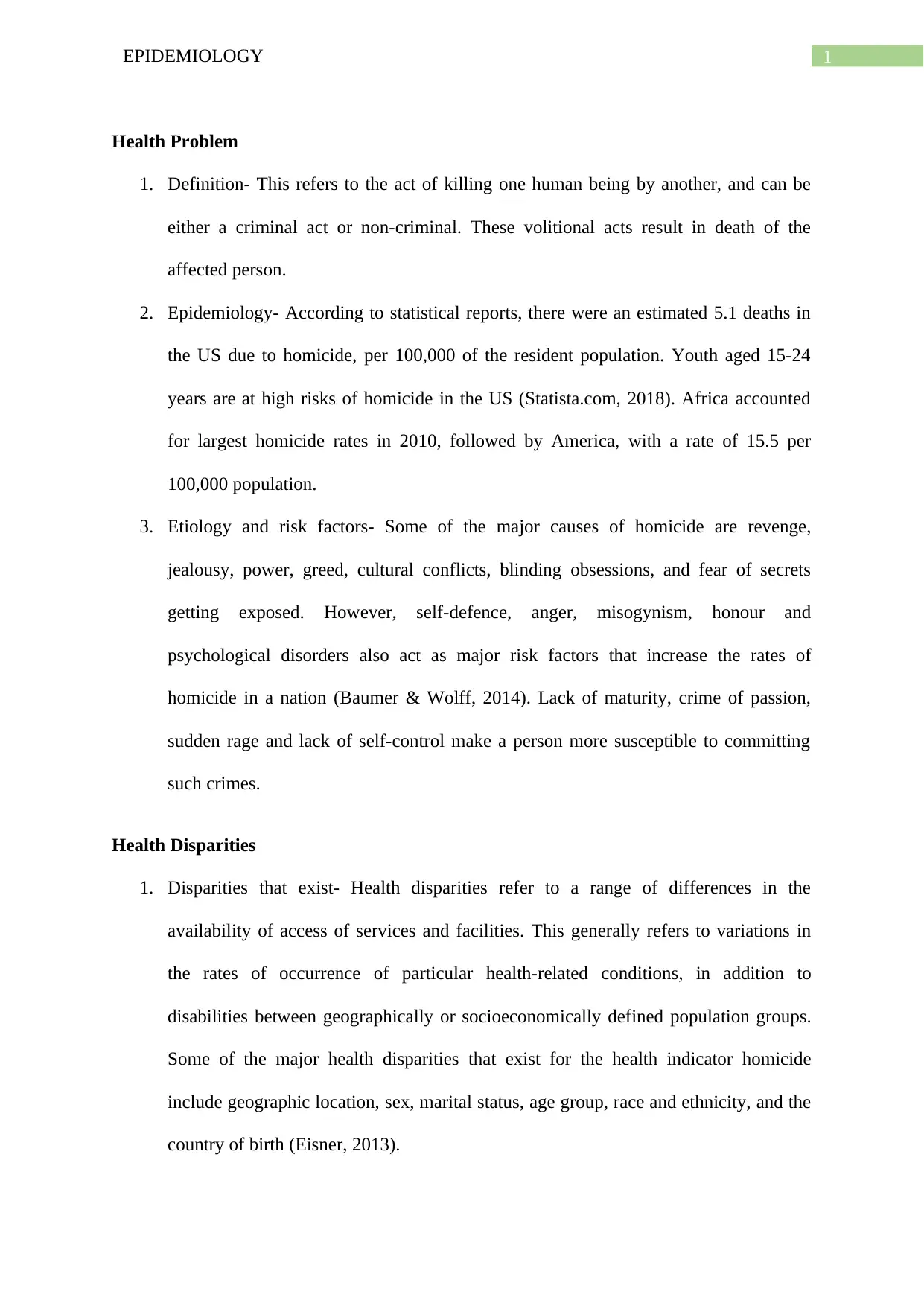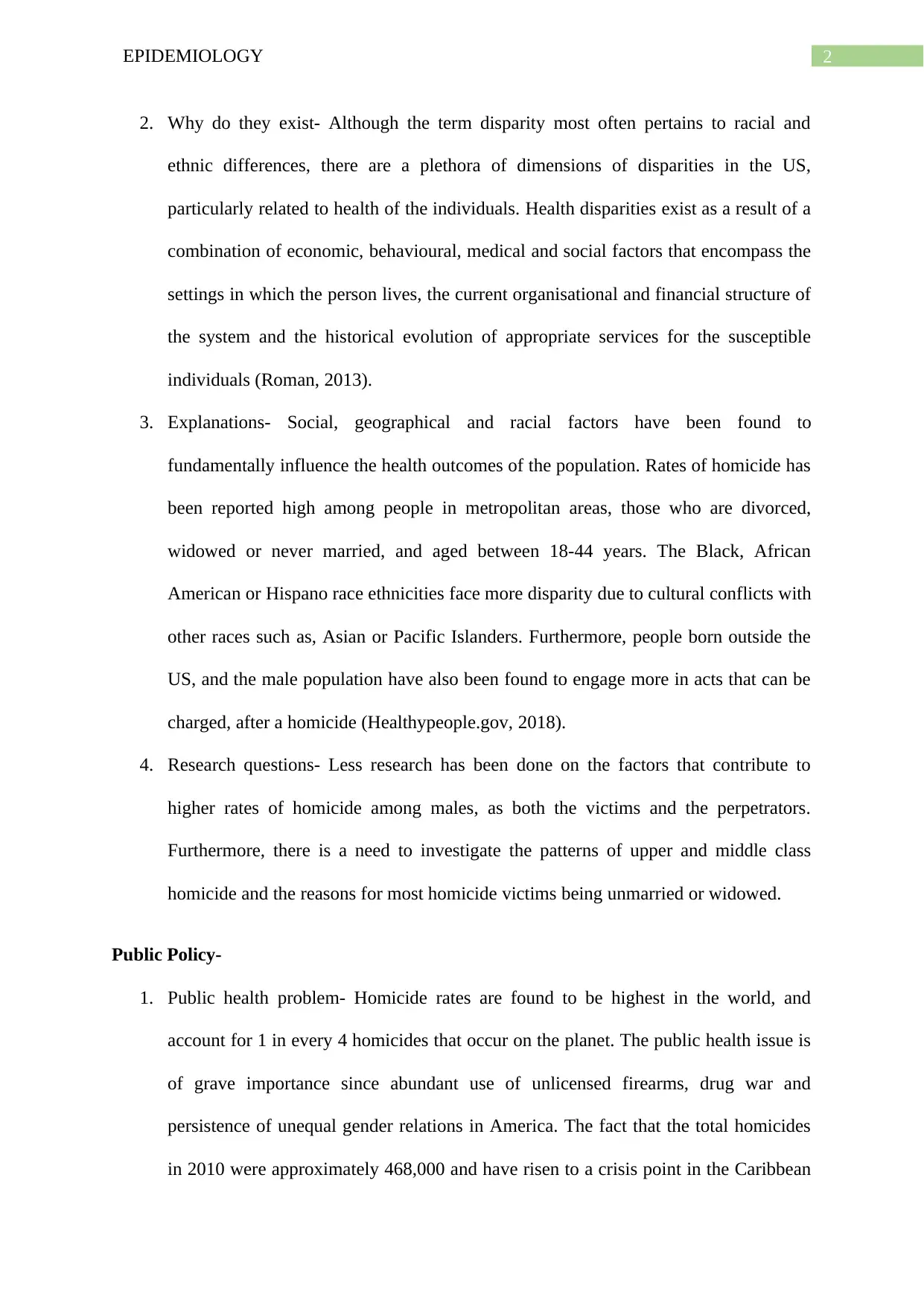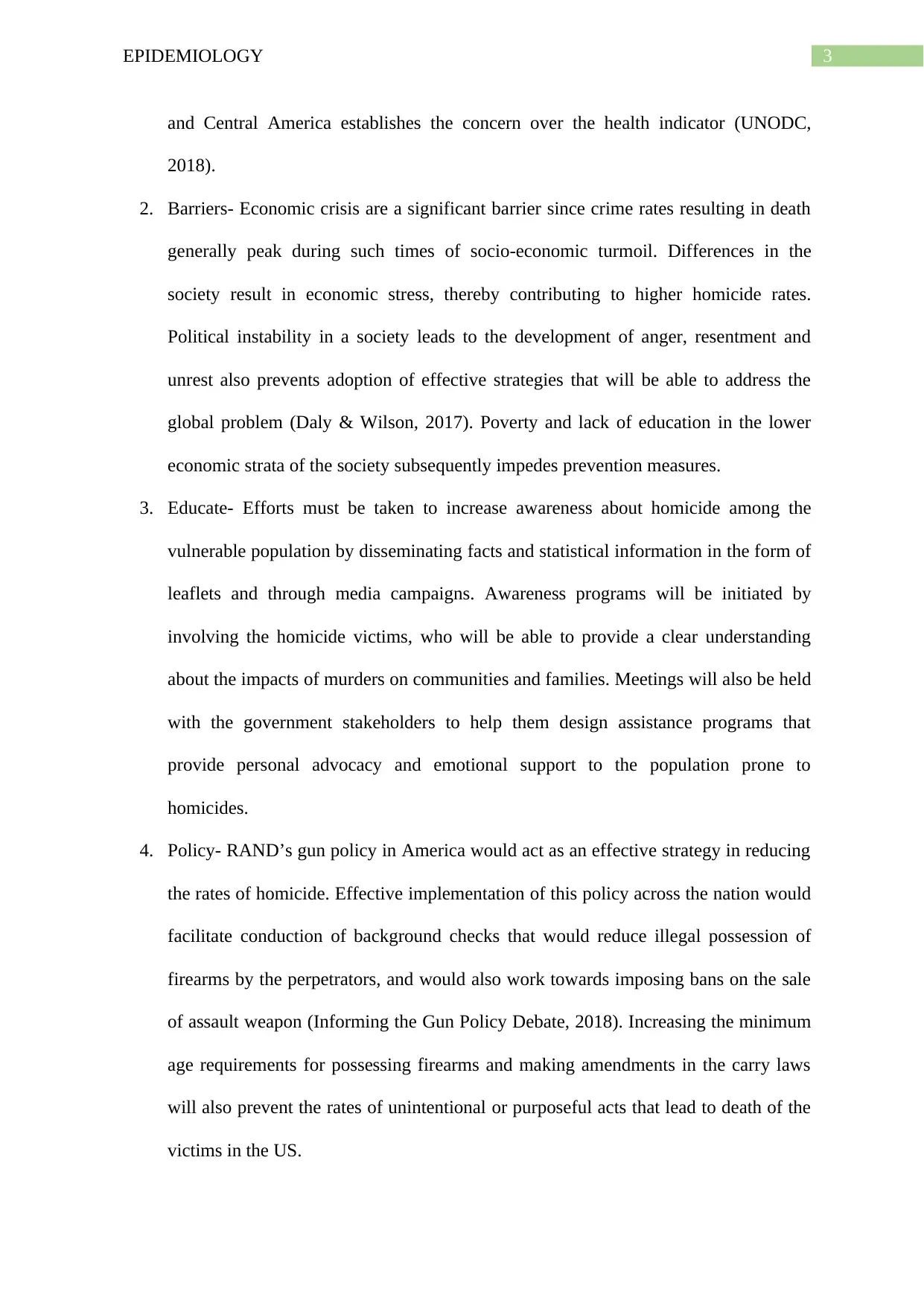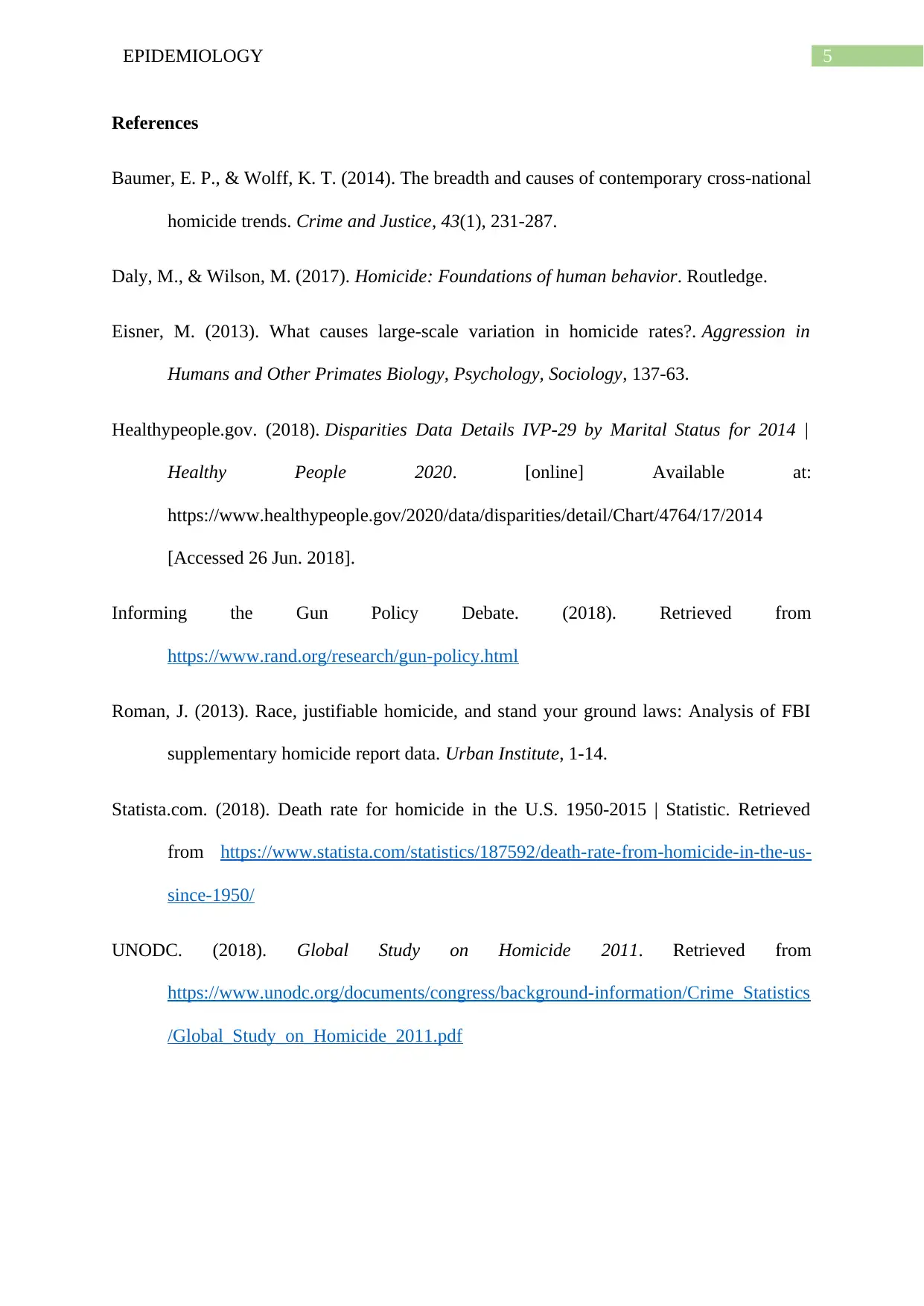Health Disparities Research Paper on Homicide Epidemiology
VerifiedAdded on 2023/06/10
|6
|1185
|454
AI Summary
This research paper discusses the epidemiology, health disparities, public policy, and research questions related to homicide. It also highlights the causes, risk factors, and barriers to prevention of homicide.
Contribute Materials
Your contribution can guide someone’s learning journey. Share your
documents today.

Running head: EPIDEMIOLOGY
Health Disparities Research Paper
Name of the Student
Name of the University
Author Note
Health Disparities Research Paper
Name of the Student
Name of the University
Author Note
Secure Best Marks with AI Grader
Need help grading? Try our AI Grader for instant feedback on your assignments.

1EPIDEMIOLOGY
Health Problem
1. Definition- This refers to the act of killing one human being by another, and can be
either a criminal act or non-criminal. These volitional acts result in death of the
affected person.
2. Epidemiology- According to statistical reports, there were an estimated 5.1 deaths in
the US due to homicide, per 100,000 of the resident population. Youth aged 15-24
years are at high risks of homicide in the US (Statista.com, 2018). Africa accounted
for largest homicide rates in 2010, followed by America, with a rate of 15.5 per
100,000 population.
3. Etiology and risk factors- Some of the major causes of homicide are revenge,
jealousy, power, greed, cultural conflicts, blinding obsessions, and fear of secrets
getting exposed. However, self-defence, anger, misogynism, honour and
psychological disorders also act as major risk factors that increase the rates of
homicide in a nation (Baumer & Wolff, 2014). Lack of maturity, crime of passion,
sudden rage and lack of self-control make a person more susceptible to committing
such crimes.
Health Disparities
1. Disparities that exist- Health disparities refer to a range of differences in the
availability of access of services and facilities. This generally refers to variations in
the rates of occurrence of particular health-related conditions, in addition to
disabilities between geographically or socioeconomically defined population groups.
Some of the major health disparities that exist for the health indicator homicide
include geographic location, sex, marital status, age group, race and ethnicity, and the
country of birth (Eisner, 2013).
Health Problem
1. Definition- This refers to the act of killing one human being by another, and can be
either a criminal act or non-criminal. These volitional acts result in death of the
affected person.
2. Epidemiology- According to statistical reports, there were an estimated 5.1 deaths in
the US due to homicide, per 100,000 of the resident population. Youth aged 15-24
years are at high risks of homicide in the US (Statista.com, 2018). Africa accounted
for largest homicide rates in 2010, followed by America, with a rate of 15.5 per
100,000 population.
3. Etiology and risk factors- Some of the major causes of homicide are revenge,
jealousy, power, greed, cultural conflicts, blinding obsessions, and fear of secrets
getting exposed. However, self-defence, anger, misogynism, honour and
psychological disorders also act as major risk factors that increase the rates of
homicide in a nation (Baumer & Wolff, 2014). Lack of maturity, crime of passion,
sudden rage and lack of self-control make a person more susceptible to committing
such crimes.
Health Disparities
1. Disparities that exist- Health disparities refer to a range of differences in the
availability of access of services and facilities. This generally refers to variations in
the rates of occurrence of particular health-related conditions, in addition to
disabilities between geographically or socioeconomically defined population groups.
Some of the major health disparities that exist for the health indicator homicide
include geographic location, sex, marital status, age group, race and ethnicity, and the
country of birth (Eisner, 2013).

2EPIDEMIOLOGY
2. Why do they exist- Although the term disparity most often pertains to racial and
ethnic differences, there are a plethora of dimensions of disparities in the US,
particularly related to health of the individuals. Health disparities exist as a result of a
combination of economic, behavioural, medical and social factors that encompass the
settings in which the person lives, the current organisational and financial structure of
the system and the historical evolution of appropriate services for the susceptible
individuals (Roman, 2013).
3. Explanations- Social, geographical and racial factors have been found to
fundamentally influence the health outcomes of the population. Rates of homicide has
been reported high among people in metropolitan areas, those who are divorced,
widowed or never married, and aged between 18-44 years. The Black, African
American or Hispano race ethnicities face more disparity due to cultural conflicts with
other races such as, Asian or Pacific Islanders. Furthermore, people born outside the
US, and the male population have also been found to engage more in acts that can be
charged, after a homicide (Healthypeople.gov, 2018).
4. Research questions- Less research has been done on the factors that contribute to
higher rates of homicide among males, as both the victims and the perpetrators.
Furthermore, there is a need to investigate the patterns of upper and middle class
homicide and the reasons for most homicide victims being unmarried or widowed.
Public Policy-
1. Public health problem- Homicide rates are found to be highest in the world, and
account for 1 in every 4 homicides that occur on the planet. The public health issue is
of grave importance since abundant use of unlicensed firearms, drug war and
persistence of unequal gender relations in America. The fact that the total homicides
in 2010 were approximately 468,000 and have risen to a crisis point in the Caribbean
2. Why do they exist- Although the term disparity most often pertains to racial and
ethnic differences, there are a plethora of dimensions of disparities in the US,
particularly related to health of the individuals. Health disparities exist as a result of a
combination of economic, behavioural, medical and social factors that encompass the
settings in which the person lives, the current organisational and financial structure of
the system and the historical evolution of appropriate services for the susceptible
individuals (Roman, 2013).
3. Explanations- Social, geographical and racial factors have been found to
fundamentally influence the health outcomes of the population. Rates of homicide has
been reported high among people in metropolitan areas, those who are divorced,
widowed or never married, and aged between 18-44 years. The Black, African
American or Hispano race ethnicities face more disparity due to cultural conflicts with
other races such as, Asian or Pacific Islanders. Furthermore, people born outside the
US, and the male population have also been found to engage more in acts that can be
charged, after a homicide (Healthypeople.gov, 2018).
4. Research questions- Less research has been done on the factors that contribute to
higher rates of homicide among males, as both the victims and the perpetrators.
Furthermore, there is a need to investigate the patterns of upper and middle class
homicide and the reasons for most homicide victims being unmarried or widowed.
Public Policy-
1. Public health problem- Homicide rates are found to be highest in the world, and
account for 1 in every 4 homicides that occur on the planet. The public health issue is
of grave importance since abundant use of unlicensed firearms, drug war and
persistence of unequal gender relations in America. The fact that the total homicides
in 2010 were approximately 468,000 and have risen to a crisis point in the Caribbean

3EPIDEMIOLOGY
and Central America establishes the concern over the health indicator (UNODC,
2018).
2. Barriers- Economic crisis are a significant barrier since crime rates resulting in death
generally peak during such times of socio-economic turmoil. Differences in the
society result in economic stress, thereby contributing to higher homicide rates.
Political instability in a society leads to the development of anger, resentment and
unrest also prevents adoption of effective strategies that will be able to address the
global problem (Daly & Wilson, 2017). Poverty and lack of education in the lower
economic strata of the society subsequently impedes prevention measures.
3. Educate- Efforts must be taken to increase awareness about homicide among the
vulnerable population by disseminating facts and statistical information in the form of
leaflets and through media campaigns. Awareness programs will be initiated by
involving the homicide victims, who will be able to provide a clear understanding
about the impacts of murders on communities and families. Meetings will also be held
with the government stakeholders to help them design assistance programs that
provide personal advocacy and emotional support to the population prone to
homicides.
4. Policy- RAND’s gun policy in America would act as an effective strategy in reducing
the rates of homicide. Effective implementation of this policy across the nation would
facilitate conduction of background checks that would reduce illegal possession of
firearms by the perpetrators, and would also work towards imposing bans on the sale
of assault weapon (Informing the Gun Policy Debate, 2018). Increasing the minimum
age requirements for possessing firearms and making amendments in the carry laws
will also prevent the rates of unintentional or purposeful acts that lead to death of the
victims in the US.
and Central America establishes the concern over the health indicator (UNODC,
2018).
2. Barriers- Economic crisis are a significant barrier since crime rates resulting in death
generally peak during such times of socio-economic turmoil. Differences in the
society result in economic stress, thereby contributing to higher homicide rates.
Political instability in a society leads to the development of anger, resentment and
unrest also prevents adoption of effective strategies that will be able to address the
global problem (Daly & Wilson, 2017). Poverty and lack of education in the lower
economic strata of the society subsequently impedes prevention measures.
3. Educate- Efforts must be taken to increase awareness about homicide among the
vulnerable population by disseminating facts and statistical information in the form of
leaflets and through media campaigns. Awareness programs will be initiated by
involving the homicide victims, who will be able to provide a clear understanding
about the impacts of murders on communities and families. Meetings will also be held
with the government stakeholders to help them design assistance programs that
provide personal advocacy and emotional support to the population prone to
homicides.
4. Policy- RAND’s gun policy in America would act as an effective strategy in reducing
the rates of homicide. Effective implementation of this policy across the nation would
facilitate conduction of background checks that would reduce illegal possession of
firearms by the perpetrators, and would also work towards imposing bans on the sale
of assault weapon (Informing the Gun Policy Debate, 2018). Increasing the minimum
age requirements for possessing firearms and making amendments in the carry laws
will also prevent the rates of unintentional or purposeful acts that lead to death of the
victims in the US.
Secure Best Marks with AI Grader
Need help grading? Try our AI Grader for instant feedback on your assignments.

4EPIDEMIOLOGY

5EPIDEMIOLOGY
References
Baumer, E. P., & Wolff, K. T. (2014). The breadth and causes of contemporary cross-national
homicide trends. Crime and Justice, 43(1), 231-287.
Daly, M., & Wilson, M. (2017). Homicide: Foundations of human behavior. Routledge.
Eisner, M. (2013). What causes large-scale variation in homicide rates?. Aggression in
Humans and Other Primates Biology, Psychology, Sociology, 137-63.
Healthypeople.gov. (2018). Disparities Data Details IVP-29 by Marital Status for 2014 |
Healthy People 2020. [online] Available at:
https://www.healthypeople.gov/2020/data/disparities/detail/Chart/4764/17/2014
[Accessed 26 Jun. 2018].
Informing the Gun Policy Debate. (2018). Retrieved from
https://www.rand.org/research/gun-policy.html
Roman, J. (2013). Race, justifiable homicide, and stand your ground laws: Analysis of FBI
supplementary homicide report data. Urban Institute, 1-14.
Statista.com. (2018). Death rate for homicide in the U.S. 1950-2015 | Statistic. Retrieved
from https://www.statista.com/statistics/187592/death-rate-from-homicide-in-the-us-
since-1950/
UNODC. (2018). Global Study on Homicide 2011. Retrieved from
https://www.unodc.org/documents/congress/background-information/Crime_Statistics
/Global_Study_on_Homicide_2011.pdf
References
Baumer, E. P., & Wolff, K. T. (2014). The breadth and causes of contemporary cross-national
homicide trends. Crime and Justice, 43(1), 231-287.
Daly, M., & Wilson, M. (2017). Homicide: Foundations of human behavior. Routledge.
Eisner, M. (2013). What causes large-scale variation in homicide rates?. Aggression in
Humans and Other Primates Biology, Psychology, Sociology, 137-63.
Healthypeople.gov. (2018). Disparities Data Details IVP-29 by Marital Status for 2014 |
Healthy People 2020. [online] Available at:
https://www.healthypeople.gov/2020/data/disparities/detail/Chart/4764/17/2014
[Accessed 26 Jun. 2018].
Informing the Gun Policy Debate. (2018). Retrieved from
https://www.rand.org/research/gun-policy.html
Roman, J. (2013). Race, justifiable homicide, and stand your ground laws: Analysis of FBI
supplementary homicide report data. Urban Institute, 1-14.
Statista.com. (2018). Death rate for homicide in the U.S. 1950-2015 | Statistic. Retrieved
from https://www.statista.com/statistics/187592/death-rate-from-homicide-in-the-us-
since-1950/
UNODC. (2018). Global Study on Homicide 2011. Retrieved from
https://www.unodc.org/documents/congress/background-information/Crime_Statistics
/Global_Study_on_Homicide_2011.pdf
1 out of 6
Related Documents
Your All-in-One AI-Powered Toolkit for Academic Success.
+13062052269
info@desklib.com
Available 24*7 on WhatsApp / Email
![[object Object]](/_next/static/media/star-bottom.7253800d.svg)
Unlock your academic potential
© 2024 | Zucol Services PVT LTD | All rights reserved.





